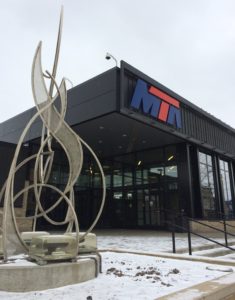By Nic Custer
The Flint Mass Transportation Authority is working to increase routes, make bus stops more accessible, integrate scheduling apps and electronic payment and replace 160 of its 280 vehicles over the next decade.

MTA headquarters on Harrison Street in downtown Flint (photo by Jan Worth-Nelson)
These are essential priorities offered in MTA’s recently released 2016-2026 Strategic Plan. The new plan was informed by community feedback from rider surveys and advisory councils made up of riders and stakeholders.
MTA officials report the system provides 5.5 million rides a year using 145 buses and 138 YOUR Ride vehicles.
Noting that in Genesee County more than 80,000 people “are affected by some form of disability,” MTA Board Chair Paul D. Newman wrote in a forward to the Strategic Plan document, “a full family of services that provide the highest level of independence is a priority.”
The organization plans to be responsive to customer needs by focusing on innovation, accessibility and sustainability over the next decade, according to Harmony Lloyd, Director of Planning, Innovation and External Affairs.
The plan calls for 38 recommended “action strategies” over the next ten years, along with a timeline for achieving them. The executive summary of the report notes, however, that the system currently is operating at capacity and that “new or expanded services will require an infusion of new operating and capital dollars.”
Federal grant funds natural gas
In January the system got a major boost when it received $12.8 million in federal funds to replace 32 diesel buses with compressed natural gas buses.
Lloyd said, “The new buses will provide a more comfortable, reliable experience for our riders while also utilizing a cleaner, sustainable fuel source.”
The plan document states the system aims to “realize an annual reduction of over 1/2 million gallons of diesel fuel” in the coming years.
More than 34 per cent of the MTA’s fleet is now fueled with propane, compressed natural gas, or hydrogen fuel cells. MTA will purchase more compressed natural gas buses as they replace older vehicles in the next few years. Flynn said officials also are investigating electric buses but the infrastructure is not developed enough yet in the region to be a practical solution.
Lloyd said the MTA aims to employ more technology-based solutions to improve quality of ridership. This could include phone apps or text notifications on whether a bus will be late or when YOUR Ride has arrived. Lloyd said there still are many questions to solve in regards to what will benefit the largest number of users and what will be the best use of resources.
Lloyd said one priority is to establish electronic fare payments within the next five years. But this would require a substantial investment in retrofitting MTA vehicles.
Meeting needs of aging population
Lloyd said more residents are now aging in place at home and rely on transportation services to remain independent. MTA officials see an opportunity to offer specialized services that connect riders with medical transportation, grocery rides and other necessary trips, she said.
In addition to serving 4 million rides annually on regular bus routes, MTA has introduced specialized services such as Rides to Wellness, which offers trips to various Hurley and downtown medical facilities for $1.75 per ride. Rides to Groceries is a specialized service to address grocery deserts in the city. The route travels to Walmart and Kroger from the downtown station in order to provide all passengers with access to area grocery stores. Ride to Groceries costs 85 cents per ride. Countywide residents can schedule a Ride to Groceries trip with the nearest YOUR Ride Service Center for $3.50 each way. Persons 65 years or older or with a disability pay $2.25 each way.
A shuttle service for UM-Flint students is another specialized service in response to more college students living in Central Park and East Court Street area. She said the route has seen a huge jump in ridership since its launch.
Door-to-door service
MTA is currently piloting an expanded Rides to Wellness program, featuring a door-to-door, same day service through a partnership with the Genesee County Department of Health and Human Services and through Valley Agency on Aging. The program is being implemented on a limited basis with several partner agencies. For this expanded pilot project, Lloyd said MTA will blend aspects of current non-emergency medical transportation with “a robust mobility management program.” The service will include same day service to multiple locations such as the doctor, pharmacy and grocery store. It will also use online or phone app-based notification and scheduling options.
This service includes a transit navigator who passengers can call in order to help secure a ride or help find service agencies that can provide transportation. The Federal Transit Administration funded the pilot program and chose Flint because it is a leader in non-emergency medical transportation, according to Lloyd.
MTA worked with the Disability Network to conduct a bus stop accessibility study as part of its strategic planning process. The MTA was provided with best practices so all bus stops are Americans with Disability Act compliant. Lloyd said the MTA is making sure new shelters are designed and placed to be as accessible as possible. Lloyd said they are systematically assessing each of Flint’s hundreds of bus stops and prioritizing making highest traffic areas more user friendly. She said this included examining shelter placement and concrete pad size to better connect to sidewalks.
Expanding regional commuting routes

The MTA provides 5.5 million rides a year, officials report. (Photo by Jan Worth-Nelson)
The MTA also has been expanding regional routes taking passengers to work in other counties. These routes line up with work shifts traveling to metro Detroit, Livingston County and Lansing. MTA has seen the biggest ridership growth in Livingston County. More than 10,000 passengers a month use the route to travel to manufacturing companies in Livingston, which has a low unemployment rate and needs employees from elsewhere. She said many of the regional companies will even purchase bus passes for their workers to ensure they can get there.
“I get calls at least once a week from companies down there that are wanting to hire workers from this area but need to have transportation,” Lloyd said. She said it is not just people without a car that use the route but also passengers who don’t want to add wear to their own vehicles. Most commuter routes will drop employees off at companies that are clustered near each other.
Since November 2015, MTA has provided 85,000 bus passes through a partnership with the United Way, which distributes them to non-profit community agencies for their clients.
CEO sees outreach to old, new users
Edgar Benning, General Manager and CEO, explained the strategic plan’s vision through email. He wrote, “Throughout our community we face many challenges that require unique approaches to meet the transportation needs of our residents, today and into the future. As people age in place we must provide transportation options that limit isolation, provide access to medical services and groceries, and to meet basic life needs.
“At the same time,” he continued, “we have a new generation that may not choose to obtain a driver’s license or own a car. Therefore, we have the opportunity to provide transportation options that serve this population as well. As the designated public transportation provider for our community, it is incumbent upon us to provide a service that works for all in a safe, efficient, effective and sustainable manner. The strategic planning process sets the course we will follow to carry out these important public needs.”
Converting to alternate fuels
In 2012, MTA began to convert its fleet to alternative fuels for fuel cost savings and environmental benefits. YOUR Ride has already replaced 98% of its vehicles with propane-powered models. Lloyd said they will use propane to replace YOUR Ride vehicles in the immediate future.
MTA has experimented with several fuel types for replacing traditional buses including diesel-electric, hydrogen fuel cell and compressed natural gas, which is being used for many of the larger regional buses.
MTA makes its own hydrogen fuel at its Grand Blanc facility. It has three hydrogen-powered buses but the production technology is not advanced enough to be used across the entire fleet because many traditional buses are on the road for up to nine hours a day and the hydrogen technology doesn’t have enough capacity to manage that length of time, Lloyd explained.
EVM Managing Editor Nic Custer can be reached at nicpublishing@gmail.com. EVM Editor Jan Worth-Nelson contributed to this report.


You must be logged in to post a comment.